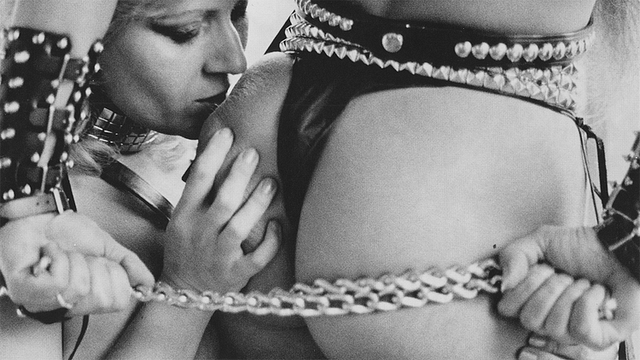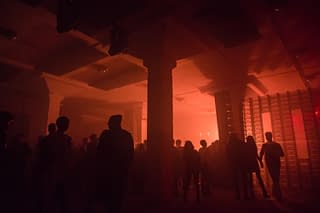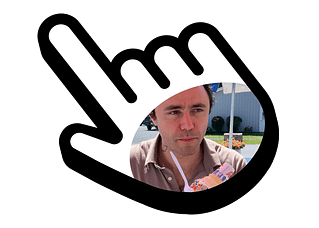
Tattoos and silver-fox forelock aside, Daemonumx’s wire-framed glasses recall eighties serial killer Ted Bundy. Projected on the movie screen behind her is a homemade invoice for a life-size sex toy from an imaginary company named Torture DollsTM. The sex toy in question? Daemonumx’s girlfriend, the astonishingly lifelike Sara Elise, who stands beside her wearing nothing but frothy pink lingerie. Daemonumx begins a QA inspection of her smiling new purchase. Tracing long, manicured fingernails where the velvet ruffles meet skin, she assesses Sara Elise against the ad copy (“pouty lips, a flowing rat tail, and supple realistic flesh,” “Screams: YES”). Once she’s satisfied, she ties up and suspends her plaything upside down, forcing her limbs into painful yet elegant contortions endured with a Barbie’s beatific mien.
Though paying close attention, the audience of fellow dykes strays far from the observant silence that New York’s Nitehawk Cinemas are famous for enforcing. Greetings ring out across rows, girlfriends gossip over bowls of popcorn, and laughter erupts at Daemonumx’s genuine, if exaggerated, horniness. An energy builds in the theater; once you’re honest about your own sadism — and judging by the state of this country, most of us experience an urge for it from time to time — you can allow yourself to enjoy the interplay between contempt and desire, anticipation and release. By the time Daemonumx begins pinning big pink bows to Sara Elise’s ass and thighs with a medical-grade staple gun, the crowd is overcome with cheers and lusty wolf whistles. Another hit from Brooklyn’s most infamous leatherdyke daddy and one of her brave bottoms.
This performance was all a warm-up (or was it the main attraction?) at a recent screening of BloodSisters: Leather, Dykes & Sadomasochism — Michelle Handelman’s seminal 1995 leatherdyke documentary — as part of Nitehawk’s BE GAY, DO CRIME film series. Daemonux was invited to perform by Shayna Maci Warner, who guest-programmed the series alongside Nitehawk film programmer Desmond Thorne. In keeping with the spirit of the film, the pre-show had everything a perv could ask for: roleplay and objectification; rope rearranging soft flesh and yielding viscera; T&A getting squeezed, stroked, and punctured. Other than the size of the audience, their scene was just like any other they might have on a Thursday night in Daemonumx’s apartment.
I’ve witnessed Daemonumx in action over the years, and played with her myself — she’s the villain who sutured my belly button shut just a few months ago — but this was the first time I’d watched her in a public forum. Perhaps that’s why I found myself wondering what straight people would think of such a display. What would they find sexy about her scene with Sara Elise, and what objectionable? Where were our differences, and where did we overlap?
Then again, the opinions of a hostile majority were on my mind even more than usual that night. I had first seen BloodSisters at the dawn of COVID, when I was still struggling to accept that it would be months, if not longer, before I could be indoors with dykes beyond my pod of four. Seeing it a second time in a packed theater on June 23, mere hours after Roe v. Wade was officially overturned, I felt that fear and fury anew. It gives me no pleasure to recognize the unrelenting relevance of the film’s themes of hard-nosed survival, calculated sexual risk, and political pleasure-seeking in this year of our lord, 2022 (and this was before America’s monkeypox outbreak joined my list of plagues to hate the government for mismanaging).
When it comes to leatherdykes, pain is the point. Yet this concept remains as inscrutable to outsiders as the politics that undergird our perversions. BloodSisters — a grungy but clear-eyed documentary — perceives our much-demonized demographic with a rare clarity.
“One of the things I’ve learned over time is that nothing scares people as much as BDSM,” Handelman said in an interview with Filmmaker Magazine last year. “And big dykes into BDSM—forget about it!”
Organized around footage from SM scenes, Bay Area leather pageants, and political protests, BloodSisters combines a series of interviews with eight San Francisco leatherdykes on identity, coming out, roleplay, consent, race, gender, and the legalities of sadomasochism (SM or S&M, in the preferred parlance of the time). A who’s who of politically inconvenient queers, transsexuals, and sexual outlaws, the film’s subjects talk at length about the problems their sexualities pose not just to the mainstream but to the feminist movements where they find repression instead of solidarity.
“Lesbian sadomasochists kind of threw a monkey wrench into that whole very simplistic theory of what sexism was, what homosexuality ought to be, what a world where women could be free would look like,” says interviewee Patrick Califia, an often-censored writer and cofounder of Samois, the first lesbian BDSM group in the United States. “We just upset people on so many theoretical levels that our presence in the women’s movement was really intolerable to feminists at that time.”
By “that time,” he’s referring to the “feminist sex wars,” a phrase used to refer to debates among feminists in the seventies and eighties regarding sex and sexuality, from which discursive maelstrom emerged anti-sex work, anti-porn, and anti-trans carceralists like Andrea Dworkin and Catharine MacKinnon. But on the left, leatherdykes and other lesbians, queer women, and trans people insisted on organizing around their sexualities in their entirety — including how they fucked, not just who. This was not always met with welcome, particularly by those feminists who sought to appeal to the mainstream, rather than build power for the genders it marginalized. “It was not okay to talk about sex of any kind openly in the lesbian community from the early seventies to the mid-seventies,” Califia tells Handelman. “And certainly if you were sexually different, you were driven out of that community in a very definite and cruel way.”
The leatherdykes of BloodSisters, alienated not only by queerness, gender, race, and class but by their allegiance to their own sexual agency, are nevertheless enthusiastic about where their desires have led them. “She stuck her fist in my cunt and I knew I was home,” says the strapping J.C. Collins, Ms. San Francisco Leather 1992 (to deafening applause from the Nitehawk crowd). Guided by nascent desires for rough sex, spankings, and bondage into San Francisco’s mysterious, and highly hermetic, leatherdyke scene, BloodSisters’s subjects implicitly resist straightwashing as they describe finding pleasures more intense — and more politically organized — than many of them had ever dreamed. “SM has always been a part of what I’ve done in bed,” says interviewee Peggy Sue. “And when it hasn’t been there, I’ve missed it.”
As was the case with porn, sex work, and other contested topics of sexual and erotic freedom, the SM lesbians of the feminist sex wars were dogged by accusations of false consciousness and perpetuating nonconsensal violence. Interviewee Tova Sewall recalls how the National Organization for Women explicitly excluded sadomasochists in the group’s 1980 statement of support for gay and lesbian rights — and conflated SM, along with pornography and public sex, with pedophilia. Meanwhile, Califia points out: “The position of the lesbian community of the time was that SM was an offshoot of the patriarchy.” But leatherdykes, who have historically shared deep connections with the patriarchy’s other refuse — among them poor, trans, disabled, and/or sex-working lesbians and queer people — have always known the difference. “Not abusive,” says Queen Cougar, “tough.” While varied, the interviewees’ musings on the nuances of consent reflect the depth of their sexual agency.
Apart from endangering and misrepresenting SM communities, scapegoating by assimilationist and even fascist-oriented feminisms also obscures their political viability. BloodSisters deftly illustrates how lesbian SM can be a configuration of queer chosen family as well as a coherent political movement. In contrast with the hetero nuclear family, leatherdyke family is intentional, in a “consensual sentient state of relationship,” as interviewee Rena Davis-Phoenix puts it. Created and maintained to meet the material needs of its members, rather than the interests of capital and the state, it’s necessarily and intrinsically political. Alongside groups like ACT UP, the Lesbian Avengers, and Housing Works, SM lesbians have long organized for rights and resources often denied them, while giving activists a place to call home.
In this sadistic world structured by state violence, a community — whether or not it’s formed around biological relationships — is survival. And in this sadistic world, feeling good can be a catalyst for real subversion, as can the redefinition of what feeling good actually means. S&M, wrote Foucault, “is the real creation of new possibilities of pleasure, which people had no idea about previously.” As Tova says in BloodSisters, “I’ve got to look to my pleasure. Pleasure is a priority.”
A lot has changed over the past three decades, and yet, as contemporary debates about leatherpeople in queer movements remind us, little has. What progress there has been for SM lesbians is the legacy, in Handelman’s eyes, of the dykes she profiled in BloodSisters.
“I always wanted this film to be a historical document of this radical group of leather women who were on the frontlines fighting for sexual freedom,” Handelman said in her Filmmaker interview. “And you can directly trace the de-pathologizing and mainstream visibility back to their activist activities.”
The first time I saw BloodSisters — alone in a blowup bed, hundreds of miles from my leather family — I turned it off as the credits began to roll. This time around, my girlfriend and I remained in the theater all the way to the final frame. Kissing cheeks and checking phones, the audience slowly milled toward the door, stopping on the way to pay homage to Handelman herself. Many were on their way to their next Pride destination, likely a dance party where they would rub shoulders with other queers, rejoining a bigger gay life of which we were merely one tiny facet. Tucked in like an Easter egg, the film’s ultimate text read like an order and a prayer all at once: Fist fuck the system.
With thanks to Michelle Handelman.


